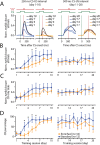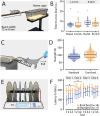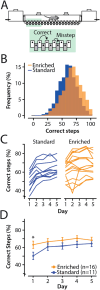Impact of enriched environment on motor performance and learning in mice
- PMID: 38472324
- PMCID: PMC10933351
- DOI: 10.1038/s41598-024-56568-3
Impact of enriched environment on motor performance and learning in mice
Abstract
Neuroscience heavily relies on animal welfare in laboratory rodents as it can significantly affect brain development, cognitive function and memory formation. Unfortunately, laboratory animals are often raised in artificial environments devoid of physical and social stimuli, potentially leading to biased outcomes in behavioural assays. To assess this effect, we examined the impact of social and physical cage enrichment on various forms of motor coordination. Our findings indicate that while enriched-housed animals did not exhibit faster learning in eyeblink conditioning, the peak timing of their conditioned responses was slightly, but significantly, improved. Additionally, enriched-housed animals outperformed animals that were housed in standard conditions in the accelerating rotarod and ErasmusLadder test. In contrast, we found no significant effect of enrichment on the balance beam and grip strength test. Overall, our data suggest that an enriched environment can improve motor performance and motor learning under challenging and/or novel circumstances, possibly reflecting an altered state of anxiety.
Keywords: Cage enrichment; Delay eyeblink conditioning; ErasmusLadder; Mice; Physical enrichment; Rotarod; Social enrichment.
© 2024. The Author(s).
Conflict of interest statement
The authors declare no competing interests.
Figures





Similar articles
-
The role of voluntary exercise in enriched rearing: a behavioral analysis.Behav Neurosci. 2006 Aug;120(4):787-803. doi: 10.1037/0735-7044.120.4.787. Behav Neurosci. 2006. PMID: 16893285
-
Adolescent enrichment partially reverses the social isolation syndrome.Brain Res Dev Brain Res. 2004 Jun 21;150(2):103-15. doi: 10.1016/j.devbrainres.2004.03.003. Brain Res Dev Brain Res. 2004. PMID: 15158074
-
Effects of environmental enrichment on exploration, anxiety, and memory in female TgCRND8 Alzheimer mice.Behav Brain Res. 2008 Aug 5;191(1):43-8. doi: 10.1016/j.bbr.2008.03.006. Epub 2008 Mar 14. Behav Brain Res. 2008. PMID: 18433890
-
Different data from different labs: lessons from studies of gene-environment interaction.J Neurobiol. 2003 Jan;54(1):283-311. doi: 10.1002/neu.10173. J Neurobiol. 2003. PMID: 12486710 Review.
-
Functional basis of associative learning and its relationships with long-term potentiation evoked in the involved neural circuits: Lessons from studies in behaving mammals.Neurobiol Learn Mem. 2015 Oct;124:3-18. doi: 10.1016/j.nlm.2015.04.006. Epub 2015 Apr 25. Neurobiol Learn Mem. 2015. PMID: 25916668 Review.
Cited by
-
The Hidden Dangers of Sedentary Living: Insights into Molecular, Cellular, and Systemic Mechanisms.Int J Mol Sci. 2024 Oct 6;25(19):10757. doi: 10.3390/ijms251910757. Int J Mol Sci. 2024. PMID: 39409085 Free PMC article. Review.
-
Acute aerobic exercise enhances associative learning in regular exercisers but not in non-regular exercisers.Front Behav Neurosci. 2025 Jan 7;18:1515682. doi: 10.3389/fnbeh.2024.1515682. eCollection 2024. Front Behav Neurosci. 2025. PMID: 39839536 Free PMC article.
-
Novel environment exposure drives temporally defined and region-specific chromatin accessibility and gene expression changes in the hippocampus.Nat Commun. 2025 Aug 21;16(1):7787. doi: 10.1038/s41467-025-63029-6. Nat Commun. 2025. PMID: 40841540 Free PMC article.
-
Complex three-dimensional rearing environments amplify compensatory plasticity following early blindness.bioRxiv [Preprint]. 2025 May 2:2025.05.02.651847. doi: 10.1101/2025.05.02.651847. bioRxiv. 2025. PMID: 40654725 Free PMC article. Preprint.
References
MeSH terms
Grants and funding
LinkOut - more resources
Full Text Sources

